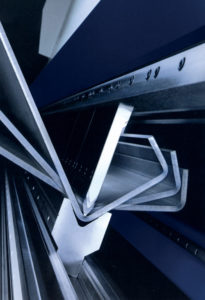Here are some “gold rules” to make bending processes fast, high-quality and efficient.
 Concerning the sheet metal bending activity, it is not sufficient to make use of suitable machinery and forefront technologies: we need also the right share of experience and matter knowledge. We are proposing hereafter some “guidelines” that offer suggestions and best practices worth pursuing by both the technical office and the workshop.
Concerning the sheet metal bending activity, it is not sufficient to make use of suitable machinery and forefront technologies: we need also the right share of experience and matter knowledge. We are proposing hereafter some “guidelines” that offer suggestions and best practices worth pursuing by both the technical office and the workshop.
1) Reducing displacements
The clever bending operator must create around the press brake an ergonomic work isle, which assures an easy loading/unloading activity of components, where parts and equipment are close and comfortably handled. Besides, he must prearrange the conditions to facilitate also the operations that follow bending, arranging the machined pieces on pallets, so that they are as comfortably and easily handled by other operators (welders, assembling operators and so on). From this point of view, it might be interesting to optimize specific solutions, prearranging, for instance, slides and trolleys to facilitate the piece handling in tidy and fast manner.
2) Optimizing NC programmes
The simple programming of the CNC is no longer sufficient, because a good programming “review” can contribute in finding new solutions and in optimizing the bending process. A typical example is the Top Dead Centre (TDC), which can be lowered through a detailed analysis of bending programmes. More in general, it is advisable to review bending programmes from time to time also, and especially, of consolidated workpieces, because in time experience can help the operator in identifying new solutions and devices to decrease times or to overcome some problems.
3) Standardizing machining operations
Standardizing machining processes means to try joining in time operations of the same type, i.e. subdividing the workpieces in such a way as to use dies and punches for the longest possible time. This practice, which may seem hardly feasible because it is not always possible to split job orders or “to foresee” what will be produced in the short term, can help in saving set-up times of machines and in tool replacement activities. This is even more important in case of medium-heavy steel structural works, where the activity is carried out on large machines by means of heavy and hardly handled equipment.
4) Proposing solutions
A bending operator, either backed by a long experience behind or who has just started his work course, must always be proactive. In other words, it is not sufficient to warn about a problem but it is always necessary to submit valid solutions and alternatives to colleagues and supervisors. The collaborative atmosphere in companies improve the work environment and, very often, gives birth to intuitions that can enhance the manufacturing efficiency of the enterprise; this obviously happens for any technological process, not just for bending. Moreover, everybody should bear in mind the famous saying: “before submitting a problem to others, consider whether you can be the problem”.
5) Unceasingly learning and communicating
Try to improve your own work and never stop learning is perhaps the most important suggestion. In other words, it is necessary taking nothing for granted and, especially, we have always to discuss with colleagues and other operators. Dialoguing, not only to solve problems but also to improve some aspects of the corporate activity, we can reach shared solutions, improving the business safety and efficiency.
We thank for the information Emiliano Corrieri, founder of the Bending Academy.



